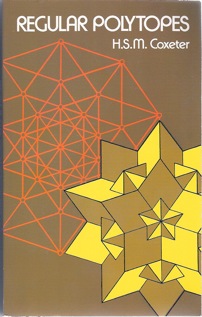Regular polytopes

Cover of the Dover edition, 1973
|
|
| Author | Harold Scott MacDonald Coxeter |
|---|---|
| Language | English |
| Subject | Geometry |
| Published | 1947 |
| Publisher | Methuen, Dover Publications |
| Pages | 321 |
| ISBN | |
| OCLC | 798003 |
| Preceded by | Dimensional Analogy (1923 essay) |
Regular Polytopes is a mathematical geometry book written by Canadian mathematician Harold Scott MacDonald Coxeter. Originally published in 1947, the book was updated and republished in 1963 and 1973.
The book is a comprehensive survey of the geometry of regular polytopes, the generalisation of regular polygons and regular polyhedra to higher dimensions. Originating with an essay entitled Dimensional Analogy written in 1923, the first edition of the book took Coxeter twenty-four years to complete.
Regular Polytopes is a standard reference work on regular polygons, polyhedra and their higher dimensional analogues. It is unusual in the breadth of its coverage; its combination of mathematical rigour with geometric insight; and the clarity of its diagrams and illustrations.
Coxeter starts by introducing two-dimensional polygons and three-dimensional polyhedra. He then gives a rigorous combinatorial definition of "regularity" and uses it to show that there are no other convex regular polyhedra apart from the five Platonic solids. The concept of "regularity" is extended to non-convex shapes such as star polygons and star polyhedra; to tessellations and honeycombs and to polytopes in higher dimensions. Coxeter introduces and uses the groups generated by reflections that became known as Coxeter groups.
The book combines algebraic rigour with clear explanations, many of which are illustrated with diagrams, and with a diagramatic notation for Wythoff constructions. The black and white plates in the book show solid models of three-dimensional polyhedra, and wire-frame models of projections of some higher-dimensional polytopes. At the end of each chapter Coxeter includes an "Historical remarks" section which provides an historical perspective of the development of the subject.
...
Wikipedia
